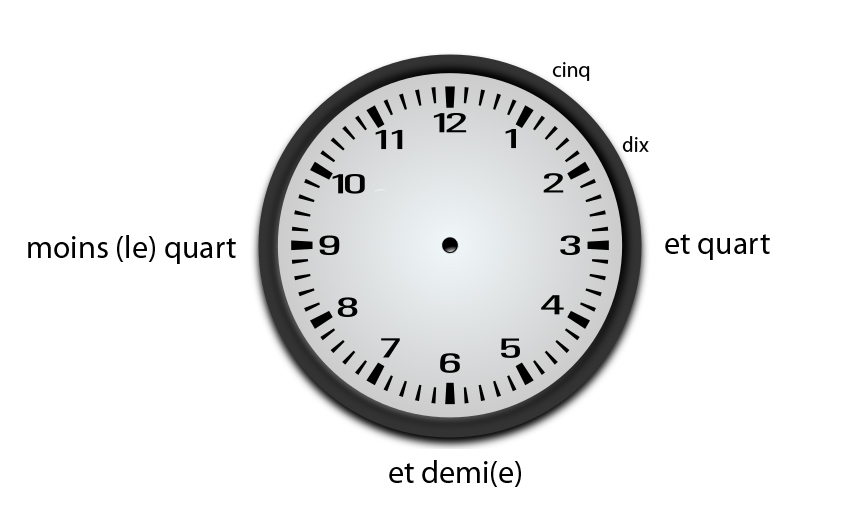Grammaire 2: l’heure
On étudie !
 “This work” by pixabay.com is in the Public Domain, CC0
“This work” by pixabay.com is in the Public Domain, CC0
| Question | Réponses | Vocabulaire |
|---|---|---|
|
Quelle heure est-il ? |
Il est # heure(s) # Il est # heure(s) et quart Il est # heure(s) et demi(e) Il est # heure(s) moins (le) quart |
du matin de l’après-midi du soir |
Quelle heure est-il ?
(a) To ask what time it is, you say Quelle heure est-il ?
(b) To answer, you say: Il est [#] heure(s).
|
(What time is it?) (It is one (1) o’clock.) |
(c) For 12:00 P.M. you simply say midi. For 12:00 A.M. you simply say minuit.
|
|
(d) To specify the number of minutes between hours we have the following options:
• For minutes up to 30, just say the number of minutes after the hour:
Il est neuf heures dix (It’s 9:10)
Il est neuf heures vingt-cinq (It’s 9:25)
• The half hour is expressed by et demi(e). You can also just say trente.
|
(It’s 9:30) (It’s 12:30)** (It’s 9:30) |
*To learn when the word demi(e) is spelled with an “e” at the end, read this article on French spelling.
• For minutes before the next hour (and after the half hour point), say moins
Il est dix heures moins dix [= It is 10 o’clock minus 10] (It’s 9:50)
- In English, we often count the minutes until the next hour (e.g., ten to eight), but in French we count backwards from the next hour (e.g., huit heures moins dix [eight (hours) minus ten])
(e) The quarter hour is expressed with the French word quart. To hear this word, click on the track below (more examples in context are provided in the ”Vocabulaire” section). Note: the u and t of ‘quart‘ are both silent!
We can either add it to the hour with et quart:
Il est neuf heures et quart (it’s 9:15)
Or subtract it from the hour with moins (le) quart:
Il est dix heures moins (le) quart (it’s 9:45)
You can also just say quinze instead of quart, like this:
Il est neuf heures quinze (It’s 9:15). Il est neuf heures moins quinze (It’s 9:45).
 “This work” by is in the Public Domain, CC0
“This work” by is in the Public Domain, CC0(f) To distinguish between A.M. and P.M. we say: du matin, de l’après-midi and du soir:
|
(It’s 2:00 A.M. It’s two in the morning.) (It’s 3:00 P.M. It’s three in the afternoon.) (It’s 8:00 P.M. It’s eight in the evening.) |
(f) The 24-hour system (sometimes called l’heure officielle) is often used and is written like this:
|
|
The 24-hour system is commonly used for formal scheduling (ie: transportation, work, entertainment schedules).
With the 24-hour system, you also avoid using “et demi(e)”, “et quart” and “moins (le) quart”, and use numbers instead.
(g) To ask someone at which time an event takes place, you say À quelle heure est…. ? (At what time is….?), where à = at:
À quelle heure est le cours de biologie? (At what time is biology class?)
You use à in your reply as well: à midi (at noon), à huit heures (at eight o’clock). Notice the differences below:
|
|
|
|
What the time is vs. at what time something happens:
|
— Quelle heure est-il? — Il est neuf heures. — À quelle heure commence ton cours de sociologie? — Il commence à dix heures. |
— (What time is it?) — (It’s nine o’clock.) — (At what time does your sociology class begin?) — (It begins at ten o’clock.) |
Ressources supplémentaires
Practice telling time: Quelle heure est-il ? You can also watch this video tutorial to review: What Time Is It?
Practice saying the time

